Degree of protection IP: interpretation of the designation of standards
Under certain conditions, any electrical device can be a source of danger. To avoid this, a marking is indicated on the case or package indicating the degree of protection IP - a combination of letters and numbers containing comprehensive information about the operating conditions of the devices.
Agree, the ability to read these markers is especially relevant when choosing equipment and devices used in difficult conditions: high humidity, dust formation, risk of mechanical stress, etc. How to find out information, decipher the markings and choose the right device, we will tell in this article.
The content of the article:
IP for electrical devices
The worldwide abbreviation IP has several possible decryption options: International Protection Marking / international security code, Internal Protection / internal protection, Ingress Protection Rating / degree of protection against interference.
Marking indicates the level of protection of the technical device from dust, solid objects, water.
The data that characterize the class of the device are determined experimentally using specially developed verification methods.
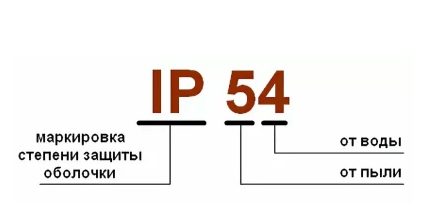
To determine the IP level, the international standard EU60529 is used, the equivalent of which is GOST 14254-96, as well as the complicated German version of DIN 40050-9.
On the territory of Russia, any equipment installed on the premises must comply with PES - the rules for the installation of electrical installations, technical specifications - TU, GOST R51330.20-99.
According to the accepted Russian and international classification, the maximum level of protection is marked with the IP68 code.
This designation indicates the complete dustproofness of the device, which is also capable of being in water for a long time, experiencing significant pressure.
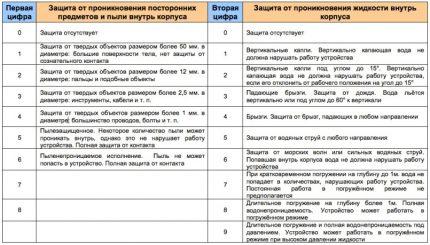
The highest degree of protection provided by the DIN system is marked as IP69-K; such marks are applied to products that are able to withstand washing with hot water, carried out at high pressure.
You can find devices that have an indefinite degree of protection. In this case, the digital designation is replaced by the letter “X”, that is, the marking will look like “IPX0”. Such a designation may also be followed by one or two Latin letters.
Decoding numbers on product labeling
Electrical appliances may contain various values on the case or in the passport / technical documentation, indicating the safety of their use in certain conditions. Below we will consider in detail what each such indicator stands for.
The first digit on the device
The first digit indicates protection against solid objects.

The notation scale includes indicators from 0 to 6:
- «0"- implies the complete absence of a protective barrier. Hazardous parts of the device with a similar marking are essentially in the public domain;
- «1"- indicates certain restrictions for the intervention of a solid object, the size of which exceeds 50 mm, as an example, you cannot penetrate into such a device with the back of your hand;
- «2"- indicates the presence of an obstacle for objects whose size exceeds 12.5 mm, which corresponds to the finger of the hand;
- «3"- speaks of the impossibility to penetrate into the apparatus with the help of locksmith tools or objects with a diameter of more than 2.5 mm;
- «4"- guarantees the protection of the equipment from ingress of any solid particles, parameter> 1 mm;
- «5"- indicates partial dust protection;
- «6»- the highest level of protection; the body of the device reliably protects the internal mechanism from the smallest elements scattered in the air.
Marking 4-6 indicates the inability to reach the live parts of the device with a needle, stud, thin wire.
Second digit marking
The next two-digit number is no less important than the previous one. Marking is indicated by numbers in the range from 0 to 8.
The ability to use the equipment in a room containing water vapor depends on it.
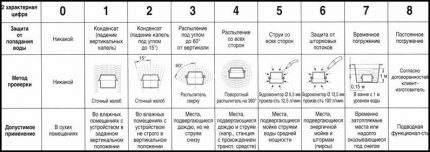
As in the previous case, “zero” means the absence of any protection, essentially open contacts.
Equipment marked with this sign may only be used in completely dry rooms that are well heated in winter.
Explanation of values:
- «1"- involves the protection of the mechanism from water droplets vertically falling on the shell of the device; without getting inside where the parts are energized, moisture flows from the surface;
- «2"- the case prevents the penetration of water droplets falling at an angle of 15 °;
- «3"- a barrier for water droplets flowing at an angle of 60 °;
- «4"- electrical devices with this indicator can be placed under the open sky, since the casing protects the mechanism from light rain and spray;
- «5"- the shell withstands weak streams of water, so that they cannot get inside;
- «6»- protection against water jets of high power;
- «7"- a device of this class can be immersed in water for a short time;
- «8»- the maximum level of protection, for devices with this marking stable operation under water for a long period is available.
Possible, but not necessary, options for combining numbers with letters.
Protection class letters
According to the standards adopted in GOST 14254-96, the letters that are placed after the numbers can be additionally used in the notation.To determine the degree of IP protection, you need to be able to read the marking, i.e., make it decrypted.
Decoding of the first letter
The symbol immediately after the numbers indicates the access parameters to the internal electrical equipment.
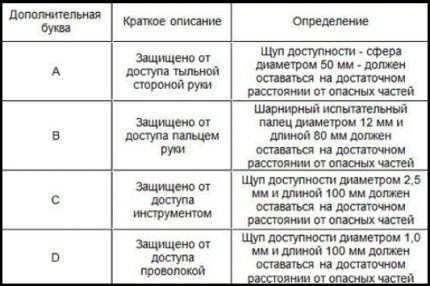
The first letter character after a two-digit number has the following meaning:
- AND - the case of such devices creates an obstacle for the penetration of large objects; live parts cannot be touched with the palm of your hand;
- AT - the shell of the device does not allow the user to touch live parts with a finger;
- WITH - reliable protection makes it impossible to contact the conductors with a screwdriver, a wrench and other tools;
- D - A perfectly fitted casing prevents the needle or thin wire from entering the device.
As an example, consider the IP20B marking. The device on which it is applied does not have any protection against moisture; it cannot be penetrated into an object with a thickness of more than 12.5 mm.
What will the second letter say?
The following letter symbol used in the marking indicates the possibility of electrical equipment functioning in special conditions.

The following Latin letters are used in the marking:
- H - high-voltage device withstanding voltage up to 72 kV;
- M - the device is able to withstand high humidity while in motion;
- S - moisture does not get into motionlessly located electrical equipment;
- W - the device has additional safety equipment that guarantees absolute protection against climatic factors: dew, wind, snow, hail, rain, hoarfrost.
It is worth noting that the current GOST has abolished the designation "W", but it may be present in the markings of age equipment
Advanced German Standard
There is also the German standard DIN 40050-9, which provides an increased level of protection IP69K, which indicates the possibility of high-temperature washing.
The devices marked with this marking are not only completely dustproof, but also withstand the extreme combination of hot water and high pressure.
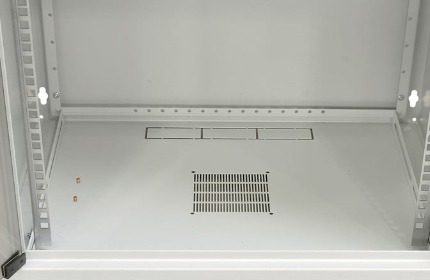
Initially, the specified level of protection was used for marking special vehicles - concrete mixers, trucks, irrigators that need regular intensive washing.
Later, the updated format was applied at the enterprises of the food and chemical industries, as well as in other areas of the national economy.
Common Electrical Appliance Labeling
Since modern electrical devices are used in a wide variety of conditions, equipment of different classes of protection against moisture and particulate matter has become widespread in everyday life and production.
Among the most popular markings are the codes IP20, IP44, IP65, IP30, IP54.
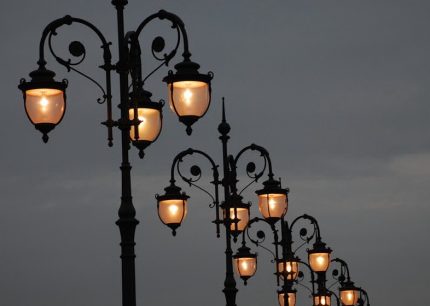
The IP20 protection level indicates that the enclosure protects against ingress of objects with a diameter of more than 12.5 mm, but does not completely prevent moisture from entering.
Devices marked with this marking are recommended to be installed in the premises of houses with dry air and good heating.
Such equipment requires a careful attitude: a not too high degree of protection against the penetration of solid objects contributes to mechanical damage.
The IP30 mark indicates the absence of protection against moisture, however, such a device better protects the device, preventing the interference of dense objects with a diameter of 2.5 mm or more.
The hard shell of IP44-class products reliably prevents the internal mechanism from being exposed to conductors, nuts, and hand tools larger than 1 mm.
At the same time, the casing guarantees protection against water vapor and splashes falling at a 60-degree angle.
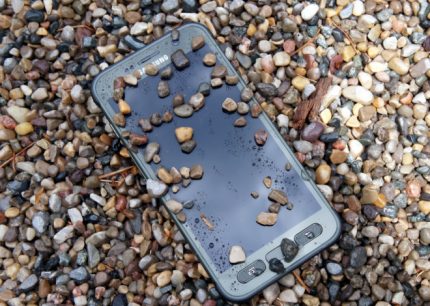
Equipment with IP44 level is suitable for installation in wet rooms and outdoors. In the latter case, it is better to put it under a canopy to protect from rain jets.
Devices of this class can also be mounted in production rooms and workshops, with the exception of places where dust piles accumulate.
Devices of IP54 class differ from those described above with full protection against interference of solid objects and the presence of partial dust protection.
They can be installed both inside and outside. However, when installing outdoors, it is advisable to consider additional shelters from atmospheric precipitation.
The IP55-rated equipment enclosure provides excellent protection against moisture and also protects against dust. Devices of this level are suitable for wet rooms, they can be installed on the street, where they can withstand even short-term rains.
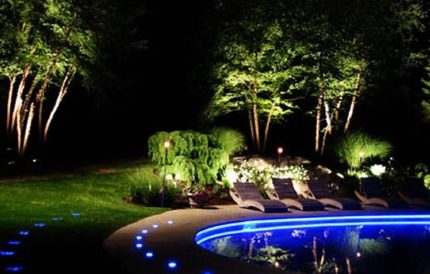
Products marked IP65 have completely dustproof properties. They can be mounted almost everywhere: in production rooms, workshops, warehouses or other dusty spaces.
Such devices are also ideal for installation in basements or cellars, which are characterized by a combination of high humidity and dust.
Electrical safety in the bathroom: IP class
A high degree of security is especially important for devices that have to function in difficult conditions.
Such rooms in the house include a bathroom, the air of which contains a high percentage of water vapor.
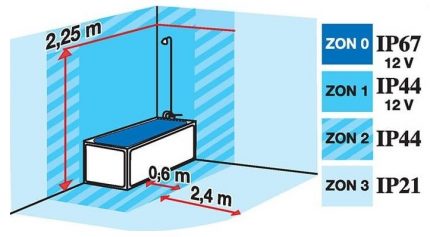
Before equipping this room, a plan should be developed in advance for the placement of electrical appliances, taking into account their distance from moisture sources.
The highest, almost 100 percent degree of humidity is observed directly at the shower or bath. In this area, low-voltage luminaires having the highest protection levels IP67 or IP68 are required.
The area above the font or shower is also considered quite dangerous: spray and steam fall in large quantities here. For installation, devices marked IP45 are suitable.
If it is planned to mount the lamp in the center of the room at a certain distance from moisture sources, it is enough to choose an IP24 or higher version.
For the driest part of the bathroom, a product marked IP22 is recommended. Some degree of protection needs to be provided due to the background moisture content in the room and the possibility of the release of steam.
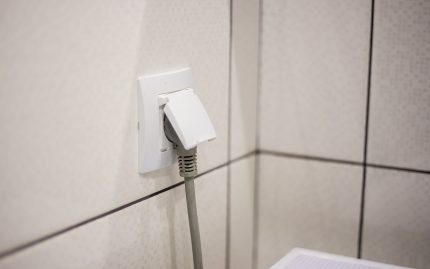
When selecting waterproof outlet it is better to give preference to one in which the moisture protection class is in the range of 4-6. If it is supposed to be placed away from the shower or font, marking is sufficient 4.
At a closer location with a possible splash, the level of protection should be higher - 5 or 6.
To equip a bath or sauna with lamps and / or other electrical appliances, you must choose electrical accessories of class IP54 and higher.
Additional information on the arrangement of the bathroom is presented in the articles:
- How to choose bathroom fixtures: which is better and why? Comparative review
- Installation of sockets in the bathroom: safety standards + installation instruction
Conclusions and useful video on the topic
The video will help you understand the degree of IP protection, which is considered on the example of various electrical appliances:
Using the device with an inadequate level of protection can lead to serious consequences: device failure, shorting of wiring and even electric shock.
In order to avoid such troubles, when choosing, you must certainly take into account the conditions in which he has to work. Before buying, you need to check the labeling, which should fully comply with the requirements.
Have something to supplement, or have questions about marking and decoding the degree of protection of IP? You can leave comments on the publication, participate in discussions and share your own experience in choosing electrical appliances. The contact form is located in the lower block.

 How much does it cost to connect gas to a private house: the price of organizing gas supply
How much does it cost to connect gas to a private house: the price of organizing gas supply  The best washing machines with dryer: model rating and customer tips
The best washing machines with dryer: model rating and customer tips  What is the color temperature of light and the nuances of choosing the temperature of the lamps to suit your needs
What is the color temperature of light and the nuances of choosing the temperature of the lamps to suit your needs  Replacement of a geyser in an apartment: replacement paperwork + basic norms and requirements
Replacement of a geyser in an apartment: replacement paperwork + basic norms and requirements